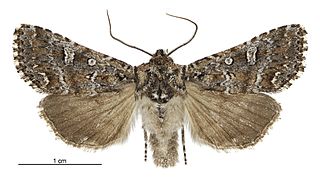
Ichneutica lithias is a moth of the family Noctuidae. This species is endemic to New Zealand. It is a small moth but distinctive as a result of the markings on its forewings. Although this species is widespread in the South Island, it has only been collected in the Rangipo Desert in the North Island. The species prefers habitat that is scrubland ranging in altitude from coastal to alpine. Adults are on the wing from October to April and larvae have been collected and reared on the New Zealand endemic plant species Melicytus alpinus.

Ichneutica olivea is a moth of the family Noctuidae. It is endemic to New Zealand and is found in the central North Island down to the central South Island. It is very similar in appearance to I. lindsayorum but has a shorter basal streak and has white scaling from the subterminal line on the forewings that I. lindsayorum lacks This species prefers shrubland habitat. The life history of I. olivea is unknown as are the host species of its larvae. The adults are on the wing from December to March and are attracted to light.

Ichneutica pelanodes is a moth of the family Noctuidae. It is endemic to New Zealand and has been found in scattered locations in the North, South and Stewart Islands. I. pelanodes is easily confused with I. skelloni as the two species are visually extremely similar. In the North Island though the range of the two species appears not to overlap. Generally of the two species I. pelanodes tends to be darker in appearance. I. pelanodes inhabits wetlands but the life history of this species is unknown as are the host species of its larvae. Adults are on the wing from October to February and are attracted both to sugar and light traps.

Ichneutica petrograpta is a moth of the family Noctuidae. This species is endemic to New Zealand where it is found in the southwest districts of the South Island, including Westland, Otago Lakes and Fiordland. It is very similar in appearance to I. mutans. It inhabits tussock and shrubland in the alpine to subalpine zones. Adults of I. petrograpta are on the wing from December to February and are attracted to sugar traps. The life history of this species is unknown as are the host species of its larvae.

Ichneutica scutata is a moth of the family Noctuidae. It is endemic to New Zealand. This species can be found in the southern parts of the North Island as well as the eastern parts of the South Island. It is similar in appearance to I. insignis and I. skelloni but can be distinguished as I. scutata is much paler in appearance. It is likely this species inhabits lowland tussock grasslands as well as coastal dunes although it is not common in inland tussock grasslands. The larvae feed on a variety of herbaceous plants such as Plantago and Convolvulus species, Plagianthus divaricatus. It pupates on soil near its host plants. The adults are on the wing from late March to July.
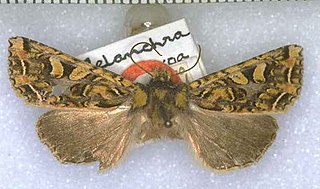
Meterana tetrachroa is a species of moth of the family Noctuidae. This species is endemic to New Zealand. It is classified as "Data Deficient" by the Department of Conservation.
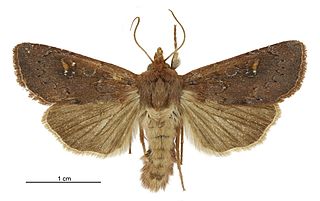
Ichneutica alopa is a moth of the family Noctuidae. It is endemic to New Zealand and is found in the central and southern parts of the North Island as well as in the South Island. It inhabits tussock grasslands and wetlands and can occur at ranges from the alpine zone down to almost sea-level. The life history of this species is unknown as are the host species of its larvae in the wild. Larvae of this species have been raised in captivity on Sphagnum moss as well as on species in the genus Raoulia. Adults of this species are on the wing from late January to April and are attracted to light and to sugar traps. I. alope can be confused with I. agorastis, I. micrastra or I. sapiens but the latter three species can be distinguished externally from I. alope through differences in size, forewing pattern and the antennae of the male of the species.
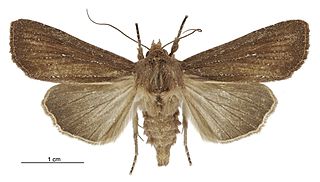
Ichneutica micrastra is a moth of the family Noctuidae. It is endemic to New Zealand. This species has been found only in the North Island and has been collected in the Northland, Auckland, Whanganui and Wellington regions. The preferred habitat of this species is wetlands and heathlands including gum fields in Northland. Adults of this species are on the wing from October to December. The life history of this species is unknown as are the host species of its larvae however it has been hypothesised that the likely larval host is a grass or grass like plant. This species is very similar in appearance to I. phaula and I. sapiens but can be distinguished as a result of differences in male antennae, the shape, colour and size of forewings, the range of the species as well as differences in genital shape.

Ichneutica steropastis, or the flax notcher moth, is a species of moth in the family Noctuidae. It is endemic to New Zealand and can be found throughout the country from the Three Kings Islands to Stewart Island as well as in the Chatham Islands. The larvae of this species feed on a variety of native and introduced plants however the New Zealand flax is one of the more well known host plants for the larvae of this moth. The larvae are nocturnal, hiding away in the base of the plants and coming out to feed at night. They create a distinctive notch in the leaf when they feed. The adults of this species are on the wing from October to March. Although adult specimens of I. steropastis are relatively easy to recognise they might possibly be confused with I. inscripta, I. theobroma or with darker forms of I. arotis. However I. steropastis can be distinguished as it has a long dark basal forewing streak that these three species lack.
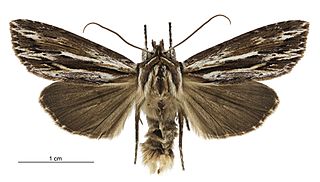
Ichneutica similis is a moth of the family Noctuidae. It is endemic to New Zealand. This species is found only in certain parts of the North Island, in the western side of the South Island and on Stewart Island. It inhabits peatlands as well as inland and coastal wetlands. The life history of this species is unknown and the host species of its larvae has yet to be confirmed. It has been hypothesised that larval host species might be within the Empodisma genus as well as possibly the species Apodasmia similis.

Ichneutica paraxysta is a moth of the family Noctuidae. It is endemic to New Zealand. This species is very similar in appearance to its close relative I. acontistis but as the range of the two species do not overlap this is unlikely to cause confusion. I. paraxysta is only found in the North Island at the subalpine zones in the Mount Taranaki region and at Mount Ruapehu. It prefers tussock grassland and shrubland habitat. The life history of this species is unknown as are the host species of its larvae however it has been hypothesised that the larval host plants are species in the genera of Poa and Festuca.
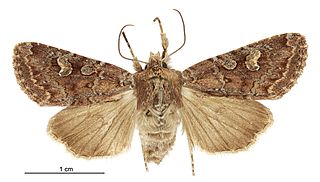
Ichneutica agorastis is a moth of the family Noctuidae. This species is endemic to New Zealand. This moth is similar in appearance to two other species in the genus but can be distinguished through the colour and size of its forewings. This species is found in the South Island and Stewart Island in open habitats in the subalpine zone. However, in Southland I. agorastis can be found down to sea-level. Adult moths are on the wing between January and April. The life history and host species are unknown.

Ichneutica panda is a species of moth in the family Noctuidae. It is endemic to New Zealand and only found in central and southern parts of the South Island. The species has not been collected in Canterbury since the late 1950s and has not been seen at The Wilderness scientific reserve since 1941. This species is similar in appearance to Ichneutica falsidica however I. panda lack or have indistinct black dashes on their edge of their hindwings. I. panda inhabit shrubland from alpine zones down to river terraces and adults are on the wing between December and February. The life history of this species is unknown as is the host species of the larvae.

Ichneutica ceraunias is a moth of the family Noctuidae. It is endemic to New Zealand. This species is found from the central North Island to the bottom of the South Island. Hosts of the larvae are species of Chionochloa and Festuca. This colourful moth is variable in appearance and can be mistaken for Ichneutica dione. Adults are on the wing from October to February.

Ichneutica chryserythra is a moth of the family Noctuidae. Living specimens have distinctive violet red coloured forewings but can be distinguished from the similar species Ichneutica marmorata as it lacks the dark edge markings of the later species. I. chryserythra can only be found in the southern parts of the South Island. Adults are on the wing between November and January. The life history of the species and the host species of its larvae are unknown.

Ichneutica falsidica is a moth of the family Noctuidae. This species is endemic to New Zealand and is widespread in the South Island but can only be found in the Tararua Range and Mount Taranaki in the North Island. This species is similar looking to I. panda but I. falsidica has dark dashes on their hind-wings. This species can be found open high country and has been seen flying during the day in sunny warm weather. At night adults are attracted to light. The life history of this species is unknown as are the host species of the larvae.
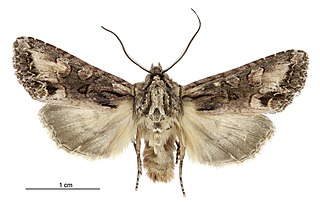
Ichneutica bromias is a moth of the family Noctuidae. This species is endemic to the Chatham Islands of New Zealand where is found on the Chatham, Pitt and Rangatira Islands. This species is similar in appearance to Ichneutica mutans but is darker and duller in its overall appearance. However, as I. mutans is not present in the Chathams this similarity is unlikely to cause confusion. The adults of the species are on the wing from November to March. The life history and the larval host species are unknown.
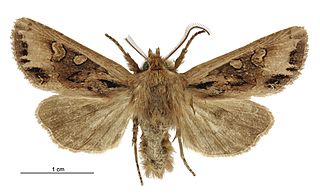
Ichneutica fenwicki is a moth of the family Noctuidae. This species is endemic to New Zealand and is found in the southern parts of the South Island and on Stewart Island. It is a distinctively coloured moth that is unlikely to be confused with closely related species. It is a spring flying moth being on the wing from September to November. The life history and host species of the larvae of I. fenwicki are unknown.
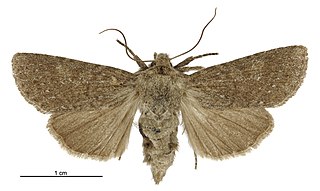
Ichneutica sollennis is a moth of the family Noctuidae. This species is endemic to New Zealand. This species is known from the eastern and central areas of the southern South Island. It inhabits alpine zones and has been collected in tussock grasslands. The life history of this species is unknown. Although the host species is currently unknown it has been hypothesised that this species have grass or grass like plants as host plants. Adults are on the wing from November to February and are attracted to light.

Ichneutica paracausta is a moth of the family Noctuidae. This species is endemic to New Zealand. It is found locally in the central North Island, is widespread in the South Island and can also be found in Stewart Island. I. paracausta is variable in colour, but as it has a distinctive black streak on its forewing as well as a wing pattern that is characteristic, I. paracausta is unlikely to be confused with other species. It is present on the North Island volcanic plateau as well as Little Bush Reserve in Hawkes Bay in the North Island as well as in tussock grassland, alpine and subalpine shrubland and in alpine forest. Larvae have been recorded as feeding on grasses, a pupa has been found in a cocoon under the bark of a tree and adult moths are on the wing from October to January.























